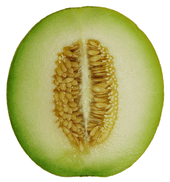Momordica charantia
Momordica charantia (colloquially: bitter melon; bitter apple; bitter gourd; bitter squash; balsam-pear; with many more names listed below)[1] is a tropical and subtropical vine of the family Cucurbitaceae, widely grown in Asia, Africa, and the Caribbean for its edible fruit. Its many varieties differ substantially in the shape and bitterness of the fruit.
| Momordica charantia | |
|---|---|
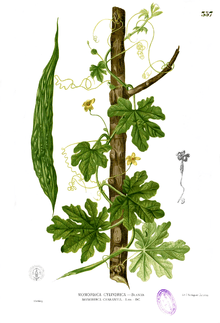 | |
| Botanical illustration of plant parts | |
| Scientific classification | |
| Kingdom: | Plantae |
| Clade: | Tracheophytes |
| Clade: | Angiosperms |
| Clade: | Eudicots |
| Clade: | Rosids |
| Order: | Cucurbitales |
| Family: | Cucurbitaceae |
| Genus: | Momordica |
| Species: | M. charantia |
| Binomial name | |
| Momordica charantia | |
Bitter melon originated in India and was introduced into China in the 14th century.[2] It is widely used in the cuisines of East Asia, South Asia, and Southeast Asia.
Alternative names
Bitter melon has many names in other languages, which have sometimes entered English as loanwords. Following are a few:
| Language | Romanized | Script |
|---|---|---|
| Malayalam | pāvaykka / kaippaykka | പാവയ്ക്ക / കൈപ്പയ്ക്ക |
| Hindi | karelā | करेला |
| Urdu | karelā | کریلا |
| Gujarati | kārelũ | કારેલું |
| Punjabi | karelā | ਕਰੇਲਾ |
| Nepali | karelo | करेलो |
| Kashmiri | karel | करेल |
| Marathi | kārlī | कारली |
| Konkani (Goa) | kārāte | कारांतें |
| Assamese | kerela | কেৰেলা |
| Bengali | kôrôla | করলা |
| Sinhala (Sri Lanka) | karavila | කරවිල |
| Haitian Creole | asosi | asosi |
| Seychellois Creole | margoz | margoz |
| Telugu | kākara | కాకర |
| Kannada | hāgalakāyi | ಹಾಗಲಕಾಯಿ |
| Tamil | pāgarkāy or pāvakāy | பாகற்காய் |
| Mandarin | kǔguā | 苦瓜 |
| Cantonese | loeng4gwaa1 | 涼瓜 |
| Korean | yeoju | 여주 |
| Japanese | nigauri | 苦瓜 |
| Okinawan | gōyā | ゴーヤー |
| Tagalog | ampalaya | ampalaya |
| Cebuano | paliya | paliya |
| Odia | kalarā | କଲରା |
| Indonesian | perai or pare | |
| Malay | peria | |
| Sranan Tongo | sopropo | |
| South Vietnamese | khổ qua | |
| North Vietnamese | mướp đắng | |
| Thai | mara kheenok | มะระขี้นก |
| Burmese | kyethinga | ကြက်ဟင်းခါး |
| Santali | Haṛhat́ karla | ᱦᱟᱲᱦᱟᱫ ᱠᱟᱨᱞᱟ |
Description
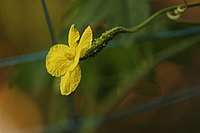
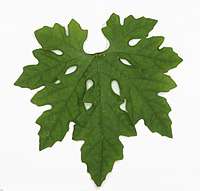
This herbaceous, tendril-bearing vine grows up to 5 m (16 ft) in length. It bears simple, alternate leaves 4–12 cm (1.6–4.7 in) across, with three to seven deeply separated lobes. Each plant bears separate yellow male and female flowers. In the Northern Hemisphere, flowering occurs during June to July and fruiting during September to November.
The fruit has a distinct warty exterior and an oblong shape. It is hollow in cross-section, with a relatively thin layer of flesh surrounding a central seed cavity filled with large, flat seeds and pith. The fruit is most often eaten green, or as it is beginning to turn yellow. At this stage, the fruit's flesh is crunchy and watery in texture, similar to cucumber, chayote or green bell pepper, but bitter. The skin is tender and edible. Seeds and pith appear white in unripe fruits; they are not intensely bitter and can be removed before cooking.
Some sources claim the flesh (rind) becomes somewhat tougher and more bitter with age, but other sources claim that at least for the common Chinese variety the skin does not change and bitterness decreases with age. The Chinese variety are best harvested light green possibly with a slight yellow tinge or just before. The pith becomes sweet and intensely red; it can be eaten uncooked in this state, and is a popular ingredient in some Southeast Asian salads.
When the fruit is fully ripe, it turns orange and soft, and splits into segments which curl back to expose seeds covered in bright red pulp.
Varieties
Bitter melon comes in a variety of shapes and sizes. The cultivar common in China is 20–30 cm (7.9–11.8 in) long, oblong with bluntly tapering ends and pale green in colour, with a gently undulating, warty surface. The bitter melon more typical of India has a narrower shape with pointed ends, and a surface covered with jagged, triangular "teeth" and ridges. It is green to white in colour. Between these two extremes are any number of intermediate forms. Some bear miniature fruit of only 6–10 cm (2.4–3.9 in) in length, which may be served individually as stuffed vegetables. These miniature fruit are popular in Bangladesh, India, Pakistan, Nepal and other countries in South Asia. The sub-continent variety is most popular in Bangladesh and India.
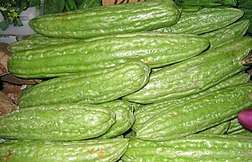
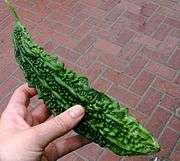
Culinary uses
| Nutritional value per 100 g (3.5 oz) | |
|---|---|
| Energy | 79 kJ (19 kcal) |
4.32 g | |
| Sugars | 1.95 g |
| Dietary fiber | 2 g |
0.18 g | |
0.84 g | |
| Vitamins | Quantity %DV† |
| Vitamin A equiv. | 1% 6 μg1% 68 μg1323 μg |
| Thiamine (B1) | 4% 0.051 mg |
| Riboflavin (B2) | 4% 0.053 mg |
| Niacin (B3) | 2% 0.28 mg |
| Pantothenic acid (B5) | 4% 0.193 mg |
| Vitamin B6 | 3% 0.041 mg |
| Folate (B9) | 13% 51 μg |
| Vitamin C | 40% 33 mg |
| Vitamin E | 1% 0.14 mg |
| Vitamin K | 5% 4.8 μg |
| Minerals | Quantity %DV† |
| Calcium | 1% 9 mg |
| Iron | 3% 0.38 mg |
| Magnesium | 5% 16 mg |
| Manganese | 4% 0.086 mg |
| Phosphorus | 5% 36 mg |
| Potassium | 7% 319 mg |
| Sodium | 0% 6 mg |
| Zinc | 8% 0.77 mg |
| Other constituents | Quantity |
| Water | 93.95 g |
| |
| †Percentages are roughly approximated using US recommendations for adults. Source: USDA Nutrient Database | |
Bitter melon is generally consumed cooked in the green or early yellowing stage. The young shoots and leaves of the bitter melon may also be eaten as greens. The fruit is very bitter raw and can be soaked in cold water and drained to remove some of those strong flavours.
In Chinese cuisine, bitter melon (苦瓜, pinyin: kǔguā; Pe̍h-ōe-jī: khó͘-koe) is valued for its bitter flavour, typically in stir-fries (often with pork and douchi), soups, dim sum, and herbal teas (gohyah tea). It has also been used in place of hops as the bittering ingredient in some beers in China and Okinawa.[3]
Bitter gourd is commonly eaten throughout India. In North Indian cuisine, it is often served with yogurt on the side to offset the bitterness, used in curry such as sabzi or stuffed with spices and then cooked in oil.
In South Indian cuisine, it is used in numerous dishes such as thoran / thuvaran (mixed with grated coconut), pavaikka mezhukkupuratti (stir-fried with spices), theeyal (cooked with roasted coconut) and pachadi (which is considered a medicinal food for diabetics), making it vital in Malayali's diet. Other popular recipes include preparations with curry, deep-frying with peanuts or other ground nuts, and Kakara kaya pulusu in Telugu, a soup with fried onions and other spices. In Karnataka bitter melon is known as hāgalakāyi (ಹಾಗಲಕಾಯಿ) in Kannada; in Tamil Nadu it is known as paagarkaai or pavakai (பாகற்காய்) in Tamil.[4] In these regions, a special preparation called pagarkai pitla, a kind of sour koottu, is common. Also commonly seen is kattu pagarkkai, a curry in which bitter melons are stuffed with onions, cooked lentil and grated coconut mix, then tied with thread and fried in oil. In the Konkan region of Maharashtra, salt is added to finely chopped bitter gourd, known as karle (कारले) in Marathi, and then it is squeezed, removing its bitter juice to some extent. After frying this with different spices, the less bitter and crispy preparation is served with grated coconut. Bitter melon is known as karate (Konkani: कारांतें) in Goa; it is valued for its health benefits and used widely in Goan cuisine.
In northern India and Nepal, bitter melon, known as tite karela (तीते करेला) in Nepali, is prepared as a fresh pickle. For this, the vegetable is cut into cubes or slices, and sautéed with oil and a sprinkle of water. When it is softened and reduced, it is crushed in a mortar with a few cloves of garlic, salt and a red or green pepper. It is also eaten sautéed to golden-brown, stuffed, or as a curry on its own or with potatoes.
In Burmese cuisine, bitter melon is sauteéd with garlic, tomatoes, spices and dried shrimp and is served as an accompaniment to other dishes. Such a dish is available at street stalls and deli counters throughout the country.
In Sri Lanka, it is known as Sinhala: කරවිල karavila and is an ingredient in many different curry dishes (e.g., karawila curry and karawila sambol) which are served mainly with rice in a main meal. Sometimes large grated coconut pieces are added, which is more common in rural areas. Karawila juice is also sometimes served there.
In Pakistan, where it is known as karela (کریلا) in Urdu-speaking areas, and Bangladesh, where it is known as korola (করলা|করলা) in Bengali, bitter melon is often cooked with onions, red chili powder, turmeric powder, salt, coriander powder, and a pinch of cumin seeds. Another dish in Pakistan calls for whole, unpeeled bitter melon to be boiled and then stuffed with cooked minced beef, served with either hot tandoori bread, naan, chappati, or with khichri (a mixture of lentils and rice).
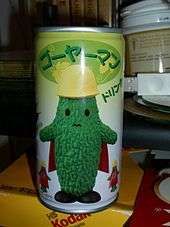
Bitter melon, known as gōyā (ゴーヤー) in Okinawan, and nigauri (苦瓜) in Japanese (although the Okinawan word gōyā is also used), is a significant ingredient in Okinawan cuisine, and is increasingly used in Japanese cuisine beyond that island.
In Indonesian cuisine, bitter melon, known as pare in Javanese and Indonesian (also paria), is prepared in various dishes, such as gado-gado, and also stir-fried, cooked in coconut milk, or steamed. In Christian areas in Eastern Indonesia it is cooked with pork and chile, the sweetness of the pork balancing against the bitterness of the vegetable.
In Vietnamese cuisine, raw bitter melon slices known as mướp đắng or khổ qua in Vietnamese, eaten with dried meat floss and bitter melon soup with shrimp, are common dishes. Bitter melons stuffed with ground pork are commonly served as a summer soup in the south. It is also used as the main ingredient of stewed bitter melon. This dish is usually cooked for the Tết holiday, where its "bitter" name is taken as a reminder of the bitter living conditions experienced in the past.
In Thai cuisine, the Chinese variety of green bitter melon, mara (มะระ) in Thai, is prepared stuffed with minced pork and garlic, in a clear broth. It is also served sliced, stir-fried with garlic and fish sauce until just tender. Varieties found in Thailand range from large fruit to small fruit. The smallest fruit variety (mara khii nok) is generally not cultivated, but is occasionally found in the wild and is considered the most nutritious variety.
In the cuisine of the Philippines, bitter melon, known as ampalaya in Tagalog and parya in Ilokano, may be stir-fried with ground beef and oyster sauce, or with eggs and diced tomato. The dish pinakbet, popular in the Ilocos region of Luzon, consists mainly of bitter melons, eggplant, okra, string beans, tomatoes, lima beans, and other various regional vegetables all stewed together with a little bagoong-based stock.
In Trinidad and Tobago, bitter melons, known as caraille or carilley, are usually sautéed with onion, garlic and scotch bonnet pepper until almost crisp.
In Mauritius, bitter melons are known as margose or margoze.
Traditional medicinal uses
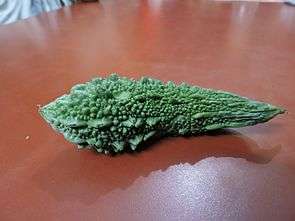
Bitter melon has been used in various Asian and African herbal medicine systems for a long time.[5][6] In Turkey, it has been used as a folk remedy for a variety of ailments, particularly stomach complaints.[7] In traditional medicine of India, different parts of the plant are used as claimed treatments for diabetes (particularly Polypeptide-p, an insulin analogue), and as a stomachic, laxative, antibilious, emetic, anthelmintic agent, for the treatment of cough, respiratory diseases, skin diseases, wounds, ulcer, gout, and rheumatism.[8]
Pharmacology
Momordica charantia has a number of purported uses including cancer prevention, treatment of diabetes, fever, HIV and AIDS, and infections.[9] While it has shown some potential clinical activity in laboratory experiments, "further studies are required to recommend its use".[9] In 2012, the germplasm and chemical constituents, such as momordicin within several varieties of the gourd, were being studied.[10]
For fever reduction and relief of menstrual problems, there is no scientific research to back these claims.[9] For cancer prevention, HIV and AIDS, and treatment of infections, there is preliminary laboratory research, but no clinical studies in humans showing a benefit.[9]
With regard to the use of Momordica charantia for diabetes, several animal studies and small-scale human studies have demonstrated a hypoglycemic effect of concentrated bitter melon extracts.[11][12][13] In addition, a 2014 review shows evidence that Momordica charantia, when consumed in raw or juice form, can be efficacious in lowering blood glucose levels.[14] However, multiple reviews have found that Momordica charantia does not significantly decrease fasting blood glucose levels or A1c, indicators of blood glucose control, when taken in capsule or tablet form.[14][15] Momordica charantia may be beneficial in diabetes; however, the effects seem to depend on how it is consumed.[14] More studies need to be performed in order to verify this effect.[14] The Memorial Sloan Kettering Cancer Center concludes that bitter melon "cannot be recommended as a replacement therapy for insulin or hypoglycemic drugs".[9]
In the Caribbean, tea brewed from cerasee leaves is a popular remedy for stomach and abdominal ailments. The plant grows wild in many areas, and the tea is made with freshly gathered leaves. The dried leaves in tea bags are also sold commercially and readily available for sale in stores.
Adverse effects
Reported side effects include diarrhea, abdominal pain, fever, hypoglycemia, urinary incontinence, and chest pain. Symptoms are generally mild, do not require treatment, and resolve with rest.[15]
Pregnancy
Bitter melon is contraindicated in pregnant women because it can induce bleeding, contractions, and miscarriage.[9]
Bitter melon tea
| Bitter melon tea | |
|---|---|
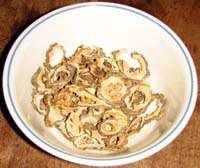 | |
| Type | Herbal tea |
| Other names | Bitter Melon, Balsam pear, Momordica chinensis |
| Origin | Brazil |
| Quick description | Traditional medicinal. Makes a green, earthy broth also used in soup. |
Bitter melon tea, also known as gohyah tea, is an herbal tea made from an infusion of dried slices of the bitter melon. It is sold as a medicinal tea, and a culinary vegetable.
A typical commercial package will make a claim similar to the following:[16]
- Gohyah Tea is good for bile, liver, dieuretic. Helpful to digestion; prevent from influenza, throat inflammation. Reduce cholesterol in the blood.
Gohyah is not listed in the Grieve's herbal database, the MPNA database at University of Michigan (Medicinal Plants of Native America, see Native American ethnobotany) or in the Phytochemical Database of the USDA - Agricultural Research Service (ARS) - National Plant Germplasm System NGRL.
Gallery
Plant
- Plant
- Leafbud
 Leaves and flower
Leaves and flower Flowers
Flowers- Male flower
- Female flower
.jpg) Two-day-old fruit with flower
Two-day-old fruit with flower Three-day-old fruit
Three-day-old fruit Ten-day-old fruit
Ten-day-old fruit- Immature fruit
 Immature fruit
Immature fruit Unripe fruits
Unripe fruits- Seeds
- Bitter melon plant growing in a container
 Commercial crop of bitter melon grown on trellises made out of plastic netting
Commercial crop of bitter melon grown on trellises made out of plastic netting_twin_female_flower.jpg) Bitter melon twin female flower
Bitter melon twin female flower Bitter melon conjoint twin fruit
Bitter melon conjoint twin fruit Momordica charantia
Momordica charantia Momordica charantia flower found at Dharmapuri ward, Oulgaret, Puducherry Union Territory
Momordica charantia flower found at Dharmapuri ward, Oulgaret, Puducherry Union Territory
Dishes and other uses
 Aloo karela bhaaji, bitter gourd and potato dish, from India.
Aloo karela bhaaji, bitter gourd and potato dish, from India. Bitter gourd dish with sauce
Bitter gourd dish with sauce.jpg) Bitter gourd cleaned and sliced for cooking
Bitter gourd cleaned and sliced for cooking
 An Indonesian-style bitter gourd dish, cooked with sambal, onion, and red bird's-eye chili peppers
An Indonesian-style bitter gourd dish, cooked with sambal, onion, and red bird's-eye chili peppers- Filipino ampalaya con carne with egg, La Familia of Baliuag, Bulacan
 Bitter gourd food supplement capsules
Bitter gourd food supplement capsules Okinawan style gōyā chanpurū (ゴーヤーチャンプルー), a stir-fried dish
Okinawan style gōyā chanpurū (ゴーヤーチャンプルー), a stir-fried dish Bitter gourd fry with potato
Bitter gourd fry with potato- Stuffed Bitter gourd with Chilli
See also
- Momordica cochinchinensis (gac)
- Momordica cymbalaria
- Momordica foetida
References
- "BSBI List 2007". Botanical Society of Britain and Ireland. Archived from the original (xls) on 2014-10-23. Retrieved 2014-10-17.
- Bagchi, Indrani (11 April 2005). "Food for thought: Green 'karela' for Red China". Times of India.
- For example, Goya Dry by Helios brewery of Okinawa
- Lim, T. K. (2013). Edible medicinal and non-medicinal plants. Dordrecht: Springer. pp. 331–332. ISBN 9789400717640.
- Grover, J. K.; Yadav, S. P. (2004). "Pharmacological actions and potential uses of Momordica charantia: A review" (PDF). Journal of Ethnopharmacology. 93 (1): 123–132. doi:10.1016/j.jep.2004.03.035. PMID 15182917. Archived from the original (PDF) on 2017-11-18.
- Beloin, N.; Gbeassor, M.; Akpagana, K.; Hudson, J.; De Soussa, K.; Koumaglo, K.; Arnason, J. T. (2005). "Ethnomedicinal uses of Momordica charantia (Cucurbitaceae) in Togo and relation to its phytochemistry and biological activity" (PDF). Journal of Ethnopharmacology. 96 (1–2): 49–55. doi:10.1016/j.jep.2004.08.009. PMID 15588650. Archived from the original (PDF) on 2019-05-27.
- "Kudret Narı Faydaları". Beslenme Desteği. 2008-10-16. Retrieved 2011-10-03.
- Wang, Limei; Waltenberger, Birgit; Pferschy-Wenzig, Eva-Maria; Blunder, Martina; Liu, Xin; Malainer, Clemens; Blazevic, Tina; Schwaiger, Stefan; Rollinger, Judith M.; Heiss, Elke H.; Schuster, Daniela; Kopp, Brigitte; Bauer, Rudolf; Stuppner, Hermann; Dirsch, Verena M.; Atanasov, Atanas G. (2014). "Natural product agonists of peroxisome proliferator-activated receptor gamma (PPARγ): a review". Biochemical Pharmacology. 92 (1): 73–89. doi:10.1016/j.bcp.2014.07.018. PMC 4212005. PMID 25083916.

- "Bitter Melon". Memorial Sloan-Kettering Cancer Center. Retrieved 17 October 2013.
- MURALI KRISHNA YELCHURI, BALA (22 January 2012). "India-Tanzania-Thailand Scientists to Study 'Bitter Gourd' for anti-diabetes". zmescience.com. Retrieved 30 May 2017.
- Wang, B. L.; Zhang, W. J.; Zhao, J; Wang, F. J.; Fan, L. Q.; Wu, Y. X.; Hu, Z. B. (2011). "Gene cloning and expression of a novel hypoglycaemic peptide from Momordica charantia". Journal of the Science of Food and Agriculture. 91 (13): 2443–8. doi:10.1002/jsfa.4485. PMID 21626510.
- Lo, H. Y.; Ho, T. Y.; Lin, C; Li, C. C.; Hsiang, C. Y. (2013). "Momordica charantia and its novel polypeptide regulate glucose homeostasis in mice via binding to insulin receptor". Journal of Agricultural and Food Chemistry. 61 (10): 2461–8. doi:10.1021/jf3042402. PMID 23414136.
- Chen, Q; Chan, L. L.; Li, E. T. (2003). "Bitter melon (Momordica charantia) reduces adiposity, lowers serum insulin and normalizes glucose tolerance in rats fed a high fat diet" (PDF). The Journal of Nutrition. 133 (4): 1088–93. doi:10.1093/jn/133.4.1088. PMID 12672924.

- Bachok, M. F.; Yusof, B. N.; Ismail, A; Hamid, A. A. (2014). "Effectiveness of traditional Malaysian vegetables (ulam) in modulating blood glucose levels" (PDF). Asia Pacific Journal of Clinical Nutrition. 23 (3): 369–76. doi:10.6133/apjcn.2014.23.3.01. PMID 25164446. Archived from the original (PDF) on 2018-05-16.
- Ooi, C. P.; Yassin, Z; Hamid, T. A. (2012). "Momordica charantia for type 2 diabetes mellitus" (PDF). The Cochrane Library. 8 (8): CD007845. doi:10.1002/14651858.CD007845.pub3. PMID 22895968.
- Technical data report for bitter melon (Momordica charantia)
External links
| Wikimedia Commons has media related to Momordica charantia. |
| Wikispecies has information related to Momordica charantia |
